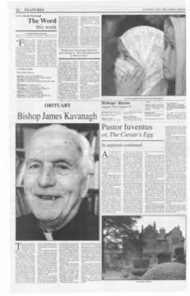Page 11, 16th August 2002
Page 11

Report an error
Noticed an error on this page?If you've noticed an error in this article please click here to report it.
Tags
Share
Related articles
Bodley Can Help Us To Rediscover Beauty
Beauty Is In The Eye Of The Needle
Shrines To The Sacraments
The Corner Of London That Was 'veritable Nuremburg'
New Architect Chosen For Cathedral
The lost legacy of 'Middle' Scott
Anthony Symondson SJ on the short, tragic career of George Gilbert Scott Jr, whose finest church was demolished in the 1950s An Architect of Promise: George Gilbert Scott Junior (1839-1897) and the Late Gothic Revival by Gavin 'Stamp, Shaun Tyas £49.50 0 ne of the greatest English architectural dynasties is the Scott family. Established by Sir George Gilbert Scott, the most prolific church architect of the Gothic Revival, from whose drawing office came a host of distinguished pupils, it continued in his sons, George Gilbert Scott Junior and John Oldrid Scott. The former was the father of Sir Giles Gilbert Scott, the architect of Liverpool Cathedral, and his brother Adrian. Richard Gilbert Scott, the architect of the new buildings at the Guildhall, London, is the son of Sir Giles.
But, of them all, the virtuoso was "Middle" Scott, of whom Giles wrote, "I always think that my father was a genius ...Grandfather was the successful practical man, and a phenomenal scholar in Gothic precedent, but Father was the artist."
Gavin Stamp lucidly and persuasively demonstrates the validity of these claims.
Few, apart from a small handful of specialists, have heard of the younger Scott today. His two greatest churches, St Agnes', Kennington Park (187489), and All Hallows, Southwark (1879-92), were destroyed in the Second World War. Their loss not only masked his achievement, but adversely affected a proper assessment of the late Gothic Revival. Yet, up to the midtwentieth century, "Middle" Scott was seen as one of the most original architects of his generation and his London churches were regarded as the apogee of modern church design. Sir Ninian Comper described St Agnes' as "that greatest work of the greatest architect of the Victorian era". Stephen Dykes Bower thought it "was not merely one of the most beautiful churches in London, it was one of the really notable works of its time". John Betjeman hyperbolically claimed that Scott was "generally recognised as the greatest genius of the Gothic Revival in England".
There are other reasons for Scott's obscurity than the loss of his best build ings. After a promising start at Eton and Jesus College, Cambridge, of which he became a Fellow, he entered his father's office and in 1878 inherited his practise and a considerable fortune.
Two years later, encouraged by Newman, he and his wife became Catholics; three years on he had a mental breakdown and was confined. His career in ruins, he drank, behaved menacingly with knives, took a French mistress, and escaped to France, where he was declared sane. His professional competence was unimpaired, but his practise was continued by Temple Lushington Moore, his pupil; he died, under his father's shadow, in the Midland Grand Hotel at St. Pancras Station in 1897. The problem was that most of this was conducted in public and in 1884 there was a harrowing trial which was sensationally reported in The Times. Among other eccentricities he would frighten women at concerts by measuring the width of their bottoms with dividers.
None of this should detract from Scott's capacity as an architect. He was one of a group in reaction against hard, muscular, mid-Victorian Gothic and the vulgarity of "Vigour" and "Go". It included G F Bodley, Thomas Garner, and John Dando Sedding, all of whom were friends and, with J F Bentley, shared common ideals.
They were men of exemplary, if conservative, taste and their buildings were characterised by beauty, strength, refinement and restraint, conceived in an English late-Decorated and Perpendicular Gothic style with discriminating references to the Continent. This represented more than a return to Pugin, because they realised the Puginian ideal in a fastidiously accomplished form that would have been impossible in his lifetime and initiated a flowering of the Gothic Revival that, in terms of purity of execution and assurance of design, had known no earlier parallel.
Stamp has broken new ground with poise and conviction. He repudiates the "Biological Fallacy" that architectural movements, like empires, progress from youth to maturity and then decline into old age, because it "not only misunderstands the later achievement of the school of Scott and Bodley, but also seriously undervalues the quality of the earlier Gothic Revival, before Pugin". The Fallacy has long represented historical orthodoxy and "grossly underestimated the extent to which mid-Victorian designers were dependent upon Italian or French precedents". The 1850s and 60s are still seen as a sununit and fulfilment of the Gothic Revival.
Scott's noble, abstract churches in the bare style with their beautiful furniture and stained glass by Kemp, Burleson and Grylls, and their spacious liturgical planning, opened a new chapter of Modern Gothic that was fulfilled in the work of Temple Moore, Giles Gilbert Scott and Dykes Bower, and lasted into the 20th century. And the same could be said of the cultivated refinement of Scott's Queen Anne domestic architecture in rubbed brick and dressed stone, and the freshness and originality of his vernacular collegiate building sat St John's College, Oxford, and Pembroke College, Cambridge. He was a founder of Watts & Co, the church furnishers. Scott's church restorations are notable for their delicacy and reserve and his restoration of the hall of Peterhouse, Cambridge, decorated with flowing diapering and glass by William Morris, created one of the most beautiful rooms in the University. Scott's largest commission was the Catholic cathedral of St John the Baptist, Norwich.
Nobody will be able to look at the Gothic Revival with the same eyes after reading this book, which is based on primary sources. It opens a new chapter of historical evaluation; but I was disappointed to notice that in a work of such distinction so many literals had crept into the text.
blog comments powered by Disqus















